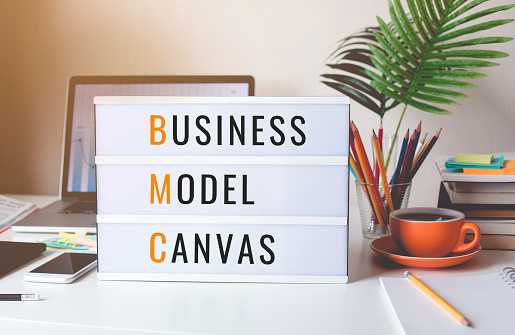Using The Business Model Canvas To Create A Great Business Plan

As an established or new business, you will always need to plan, and here is where many of us get stopped since we don't know what to do. However, there is a very simple method to create a business plan, and that is by adopting a business model canvas.
What exactly is a Business Model Canvas?
The Business Model Canvas is a strategic management tool for rapidly and simply defining and expressing a business idea or concept.
It's a one-page document that walks through the foundations of a company or product, putting out a concept logically.
Entrepreneurs should have a well-thought-out company strategy to launch their firms, remain ahead of the competition, and create income.
The Business Model Canvas is a graphic depiction of existing or new company models that are commonly utilized by strategic managers.
The Canvas gives a comprehensive picture of the business as a whole and is particularly valuable for doing a comparative study on the impact of an increase in investment on any of the contributing variables.
Reasons to adopt a Business Model Canvas
The following are five reasons why you should adopt a business model canvas
Value Proposition
Business Model Canvas is a business concept that assists you in considering what your enterprise provides to the client.
The value proposition lies at the center of the whole Business Model canvas, allowing you to stay focused on why your company exists. Great business initiatives begin with the client and work backward.
Weak enterprises begin with a product and hope that there is a demand for it.
It aids in the organization of discussions
It may be simpler for entrepreneurs to see a company model in a single streamlined form.
Some entrepreneurs bring Business Model Canvas sheets to meetings and use them to facilitate brainstorming. Grouping comments and thoughts under the nine areas help to develop ideas fast.
It's ideal for creating an ideal portfolio
The Business Model Canvas is a visual presentation that simplifies the process of drawing a business model for many concepts. It's a quick method to collect input from your team, stakeholders, advisers, and partners while also weeding out poor ideas. After you've completed the canvas, you may distribute it widely, get comments, and make any necessary changes.
Saves time
The Canvas is a mobile app that allows you to quickly test new business models and generate new ideas. You can write a one-page business model to see if the idea has legs, and then use a lean entrepreneurship approach to find customers in the market in real-time.
Gives you a comprehensive perspective of your company
The Business Model Canvas is a tool that demonstrates how your company functions as a system or ecosystem. The front stage demonstrates what creates value and how you reach and profit from customers. The backstage describes what is needed to make the front stage feasible. You may use the Canvas to understand how all of the aspects of your business are interconnected and how they inform or impact one another.
We've spoken about the benefits of a business model canvas, now let's take a look at what precisely makes up a business model canvas.
9 components of a business model canvas
Customer segmentation
A company must understand its customers' current and future needs. By segmenting your consumers based on shared characteristics such as geographical location, gender, age, habits, interests, and so on, you can better meet their needs by personalizing the solution you give them. To successfully conduct customer segmentation, a company must first identify its consumers in terms of demographics.
The company should do a thorough assessment of its customers, including an awareness of their strengths and weaknesses, as well as an investigation of alternative sorts of customers who may benefit the company more if they are focused on them.
Customer segments include the Mass Market, the Niche Market, the Multi-Sided Market, the Segmented Market, and the Diversified Market.
Value Proposition
The value proposition of a company is the mix of products and services it offers to its consumers. Value propositions might be quantitative (pricing and service speed) or qualitative (customer experience or design).
A value offer should be distinctive or distinct from those of your rivals. If you are introducing a new product, it should stand out by including novel features and qualities.
Channels
Channels are the points of contact via which your consumers may interact with your organization. There are two types of channels: company-owned channels like storefronts and partner channels like distributors.
The first step for an entrepreneur in dealing with channels is to identify the client channels. Then he or she must assess the channel's strength by doing a SWOT analysis on it.
Finally, if the firm wishes to expand its reach, it may discover and create new consumer channels.
Customer relationship
A customer journey map can assist you in identifying the many stages your consumers go through while interacting with your business. You must decide what kind of connection you will have with each of your client groups and how you will interact with them.
Personal help, automated services, and communities are all examples of client interactions. The consumer has a direct influence on the shape of the company's product or service.
The objective for an entrepreneur is to determine the sort of relationship he or she has with the consumer.
Loyal clients are relationships in which the firm should invest since they provide consistent income throughout the year.
Revenue streams
Revenue streams refer to how you intend to profit from your value proposition (what you provide your consumers and how it differs from your rivals).
You must consider the value for which your clients are willing to pay. How do you propose to capture the aforementioned value?
Direct sales, freemium, subscription, or license models might all be used. The revenue model has a large impact on how much money you make.
Key resources
Entrepreneurs must identify their key resources, which are the assets that are essential to how they deliver value to their consumers.
Human, financial, physical, and intellectual resources are the four types of resources. The firm may select how much it needs to invest in these critical resources to run a sustainable operation.
Key activities
An entrepreneur should begin by outlining the essential activities related to his or her firm. These are the most critical procedures that must take place for the business model to be effective. Key activities will correspond with income sources, therefore it is critical to assess which activities are critical by adding or eliminating some and assessing the impact.
Our fundamental value proposition necessitates thinking about which key tasks are necessary. It is divided into three categories: production, problem solution, and platform/network.
Key partnerships
Businesses can build alliances with suppliers and partners to generate efficient, streamlined operations while lowering the risks associated with any business strategy.
Partnerships may be divided into four main categories: strategic alliances between non-competitors, joint ventures, buyer-supplier ties, and buyer-supplier partnerships.
An entrepreneur must first identify essential partners before developing future collaboration arrangements.
Cost structure
Businesses can be cost-driven, focusing on reducing investment in the firm, or value-driven, focusing on giving the most value to the consumer.
The first step for an entrepreneur is to determine all expenditures involved with the firm. For each expense, it is critical to examine the item and the magnitude of the cost.
Some expenses may be reduced by specific methods, while others may be increased if you believe that investing in a specific portion would result in future benefits.
I believe you are now ready to begin creating business plans, so put the ideas in this article into practice and develop outstanding business plans.
Author Bio
Writer comprises full-time and freelance writers that form an integral part of the Editorial team of Hubslides working on different stages of content writing and publishing with overall goals of enriching the readers' knowledge through research and publishing of quality content.
Article Comments
No Comments!
At present there are zero comments on this article.
Why not be the first to make a comment?
Similar Articles
Sponsor
Search Articles
Experts Column
Latest Articles
Featured Articles
Most Popular Articles















